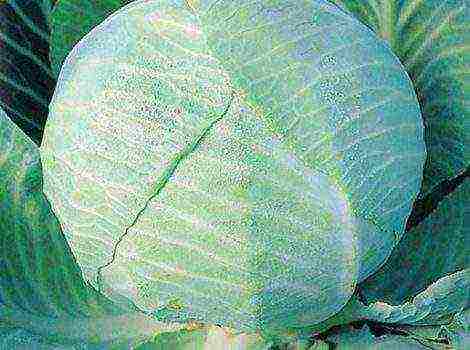Correct planting and growing potatoes according to the Kizima method
Galina Kizima's method is that there is no need to dig the ground, and you plant potatoes in a compost heap above the tubers and you will have a lot of healthy potatoes.
Who is Galina Kizima and why her method is so popular
Galina Kizima has written many books on how to grow various plants. Galina Kizima in her method took into account the peculiarities of potato growth, relying on our own experience of growing potatoes on six acres.
General essence of technology
The essence of the Kizima planting method is that potatoes are not traditionally planted in the soil, but laid out on ridges, without digging them out, and then covered with hay and all summer with plucked weeds, but without covering the growing stems of potatoes themselves.
How to plant and grow potatoes according to the Kizima method
Preparation of planting material
Select healthy tubers that are about the size of the eggs the hen lays. The tubers begin to prepare 1-1.5 months before planting.
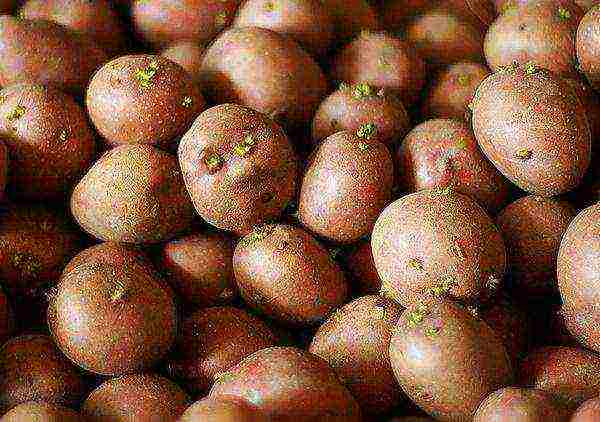
They are washed, placed in a basin, filled with clean water at a temperature +45 degrees, and leave until the water cools down. Dilute potassium permanganate and gradually pour it into the basin, thoroughly mixing water and potassium permanganate, the water should turn pink.
Then leave for 15 minutes., drain the water, wash the potatoes, dry. This procedure removes bacteria and germs from the skin.
Or replace the potassium permanganate with Fitosporin solution, diluting a small portion of Fitosporin in water so that the solution is almost transparent. Pour the diluted Fitosporin into a basin with tubers and water, leave for 30 minutes., after dry the potatoes, in this case they do not need to be washed under water.
The tubers are put under the rays of the sun for 3 weeksto turn them green. Then in their subcutaneous layer will appear poison - solanine, and tubers will not be of interest to either mice, hares, or other pests.
You can put the tubers in glass jars and place them on the windowsill, turning the jars after a certain amount of time. Or you can put a newspaper on the windowsill and put tubers on it.
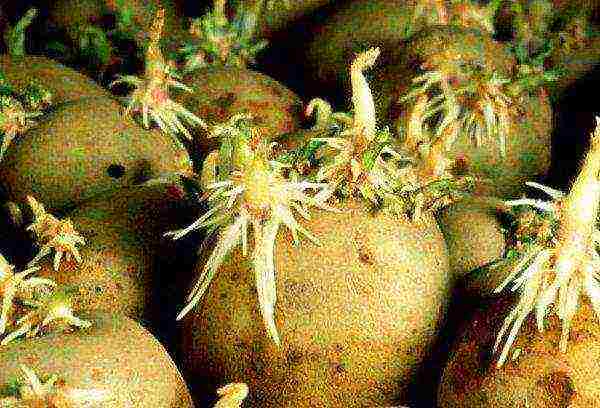
Further potatoes germinate, they are put in a cardboard box, where they germinate in the dark and warm.
Place them in 1 layer in a cardboard box so that they do not lie close to each other, cover with newspapers on top and put another layer on them, and then newspapers and a third layer of potatoes. Close the box and place on a stool near the battery. It takes about 2-3 weeks for the eyes to grow to shoots that are 4-5 cm long.
Step by step process of planting potatoes
It is well known that tubers do not grow on rhizomes, but on horizontally located shoots growing at the very bottom of the stems, they are called stolons. Stolons do not need soil, they need darkening.
There is no need to dig up the soil. Sprouted tubers spread on the virgin soil directly on the weeds.
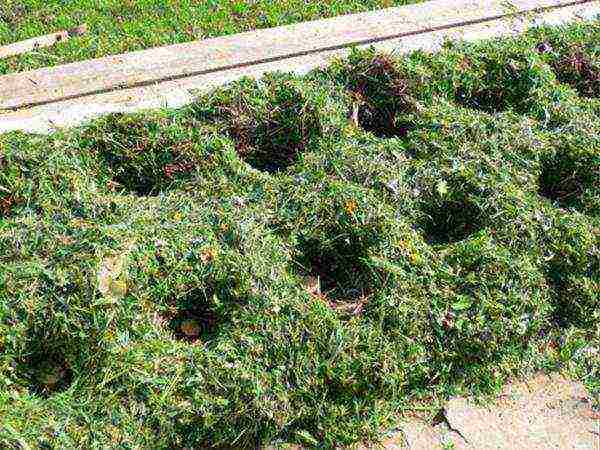
- Make 2 rows, keeping the distance between them at 0.4-0.5 m, and spread the potatoes, retreating 20-25 cm.
- Leave empty at 0.2-0.25 m from each of the rows to the aisle. That is, the width of the beds should be 0.8-1 m, and make the length you want. At 1 m, you will have 4 tubers in one row and the same number in the other.
- If you have tubers that are smaller than the size of a chicken egg, then put them in one place 2-3 each or you will have too few stems, so you will harvest a small crop.
- Do not put tubers that are larger than the size of a chicken egg, as otherwise you will grow the ground part, and the root system will develop poorly. Because of this, large potatoes cut alongso that there are the same number of shoots on each of the halves. Let them lie for 2 days, then the sections will dry out, after the sections, powder with ash so that bacteria do not get into them, and then plant.
- The more the number of stems on the potato, the more abundant the harvest, therefore it is better to have a large number of sprouts. To do this on one potato 7 days before planting, a deep cross cut with a knife is required or peel off the peel in the middle of the tuber with a thin strip in the transverse direction. Then buds will sprout at the bottom of the potato and more stems will appear.
In central areas, place a very early variety in one row and a mid-season in the other. And in the north, plant an early variety and a mid-early one.
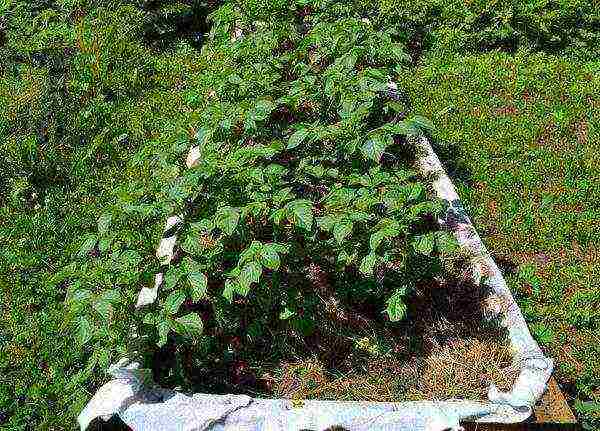
Potato care
Main - protect the beds from return frost... Because of this, cover the potatoes with hay, but not straw. It will not work as it attracts mice. You can cover the ridges with dry, fallen leaves. If you do not have any of this, then cover with newspapers or wrapping paper, having previously cut it into pieces, crumpled it up. There is no need to cover the row spacing.
So that all this covers the garden and does not scatter, put spunboid or bags on top... You can not use the film, as under it the plantings and weeds will begin to rot.
When the return frost is over, remove the spanboid and put on the garden bed all those materials from which you make a compost heap: weeds, grass. Put it on hay or newspapers, but not on potato shoots. Do it all summer long spud young potato shoots not with soil, but with mown grass.
So, you do not apply mineral fertilizers and manure, do not moisten the plantings, since the compost from weeds is 80% water, and when they rot, it is released and flows down to the root system of the potatoes.
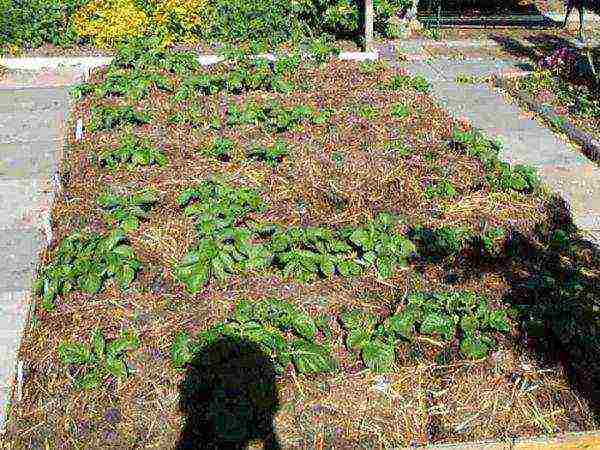
In this case, the weeds that lie under the plantings do not grow, but die, since they are not illuminated by the rays of the sun. When the potatoes bloom, tubers will begin to grow on the stolons. Cut off the flowers, as it takes a lot of energy to grow them and after cutting off the potatoes will use all their strength to form tubers.
If your planting field is too large, then simply cut off the tops of the bushesas soon as the bushes close up. So your tops will not grow in height and 2-3 additional tubers are formed.
How and when to harvest
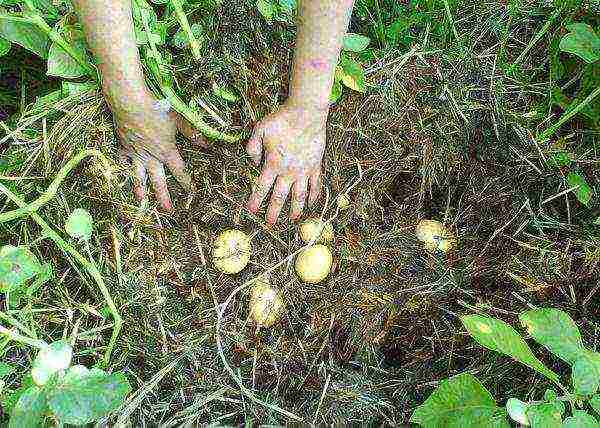
Just move the compost and pick up the largest potatoes, and then carefully place the compost in place. With this collection, the stolons will not be damaged and they will begin to grow more tubers.
When you have collected all the potatoes from the first row, spread the tops to dry out.In general, it is not advised to put the tops of tomatoes and potatoes in the compost heap, since it contains corned beef, but the corned beef will collapse from the sun's rays, precipitation and air. Leave it all for the winter.
Unripe compost has slightly acidic and or acidic characteristics; when overheated, they become neutral. But potatoes can be planted in slightly acidic or acidic soil.


